How To Clear Your Busy Mind With a Brain Dump (+ Bullet Journal Brain Dump Examples

Support Journal Smarter by buying a pdf version of How to Clear Your Busy Mind With a Brain Dump
You know those sleepless nights when you can’t stop thinking about all the tasks you haven’t completed?
The emails to reply, the laundry to wash, the family to call, the reports to write… an ever-growing list of to-dos that never seems to have an end.
How do we end up like this?
Here’s how: we commit to way too many things when we’re in a productivity high, but then, because we’re obviously not superhuman, we get overwhelmed.
But here’s the good news:
Eliminating overwhelm is easier than you think.
David Allen, the author of Getting Things Done, geniously points out that the mind is meant for having ideas, not holding on to them.
When we rely on our mind alone to remember and manage all our tasks and projects, the mind gets overloaded. We are left with no space to think clearly, to process new information, or even to focus when someone is speaking to us.
That’s why one specific practice in Getting Things Done (which is one of the most popular productivity books ever) became extremely popular:
Brain dumping.
What is a brain dump?
A brain dump is the process of emptying your mind by transposing your busy thoughts onto paper.
This practice always picks me up when I feel lost in a hurricane of thoughts and tasks. It works like magic.
In this article, I will show you:
- How and when to do a brain dump
- What to do with the ideas that come out (and organize your life once and for all!)
- How to incorporate a brain dump practice into your journal or bullet journal.
Step 1: Dump It All Out
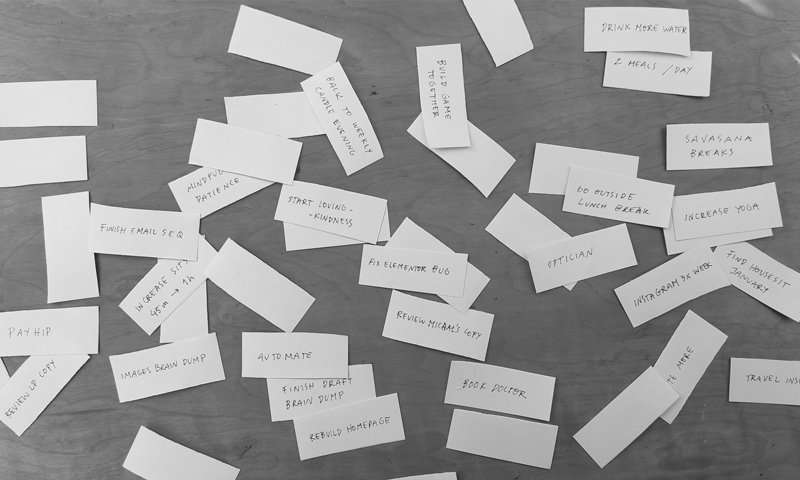
Start by writing down everything that’s on your mind right now, such as tasks, projects, unfulfilled ideas, or any other wandering thoughts—especially those that bother you on a regular basis.
You can do this step in your bullet journal, but I recommend using small papers or cards, as it will make the next steps easier. You’re aiming to get at least 100 items down.
To make sure you don’t forget anything, it might help to go through different areas of life, such as:
- Work
- Health/Fitness
- Relationships
- Official/Admin
- Spiritual
- Hobbies
- Books to read
- House tasks
- Etc.
It might also be helpful to set aside a specific time to do this (20 to 30 minutes should be enough).
Step 2: Projects, Projects, Projects
Once you’ve collected all your thoughts, it can be really useful to group them into projects.
The projects you choose will depend on what’s going on in your life right now. To give you an idea, here is an example of the list of projects from my most recent brain dump:

Some projects might coincide with the categories you chose initially, and that’s okay.
Once you’ve assigned each item to its proper project, you can move on to the next step.
Step 3: Get Your Priorities Straight
The next questions to answer are: from all these items, what’s important and what’s not? What should be done now and what should be postponed?
One project at a time, organize every item according to their priority level:
1st Priority
- Urgent / very important things
- Things you’ve already committed to
- Non-negotiable things
2nd Priority
- Things you want to do, but that aren’t urgent or very important
- Things that depend on someone/something else (eg. reviewing someone’s work)
- Things that will only happen in 2-3 weeks from now
3rd Priority
- Things you might want to do but you’re not sure yet
- Things to happen in more than 3 weeks from now
- Dreams for a distant future
4th Priority (Let Go!)
- Things which won’t really damage you if left undone
- Things you realized you can’t possibly do with everything else that comes above
- Things you really don’t want to do
This step is where your bullet journal can come into play.
Create a spread called “Projects”, and create separate boxes for each project.
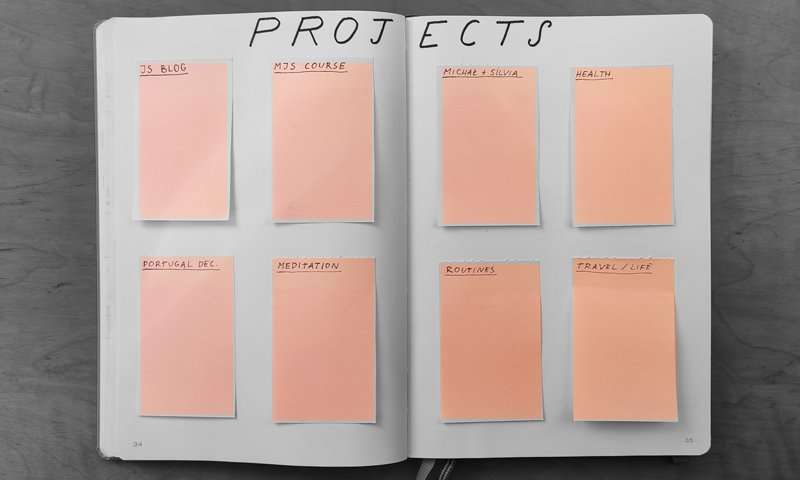
Materials used:
Then, ordered by priority, write down all the items under their corresponding project, leaving a one-line gap under each item (I’ll explain this in the next steps).
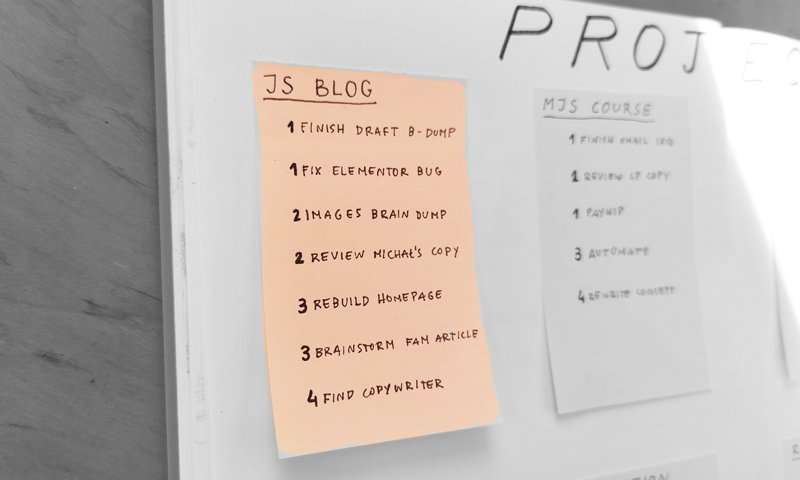
Step 4: Next… Action!
Take a look at your first project, and ask yourself:
What is the first thing to be taken care of in this list?
This will be your Next Action.
Naturally, you might want to start with items in the 1st Priority section. Choose the one that feels the most important right now, and draw an empty tick-box next to it. Resist the temptation to choose more than one: you will come back to the list later on, and after all you can only do one thing at a time.
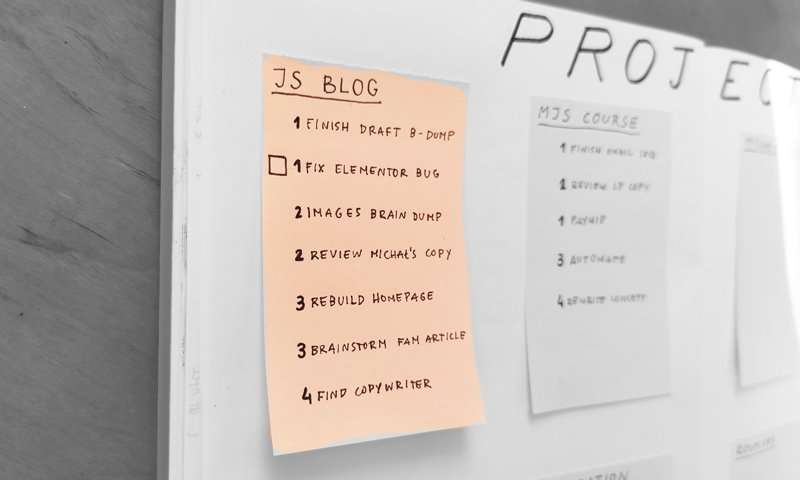
Repeat the process with each project.
Step 5: Phrase Your Next Action
Chances are that, if you’re like me, your to-do lists aren’t always… well, actual to-do lists.
For example, most people often write down things like “bank” or “Mike”.
These aren’t actionable to-dos, and we often end up subconsciously postponing them because the action is not clear enough.
So your next step is to clearly define your Next Action.
Let’s say that your Next Action was initially written as “Dad’s birthday”. You want to transform it into a very tangible action inserted within a context or timeframe, such as: “call Mom to arrange surprise party details tomorrow at 7pm”.
Remember the small gap that you left under each item? This is where you will write your newly phrased Next Action. If you want, you can cross out the old one!
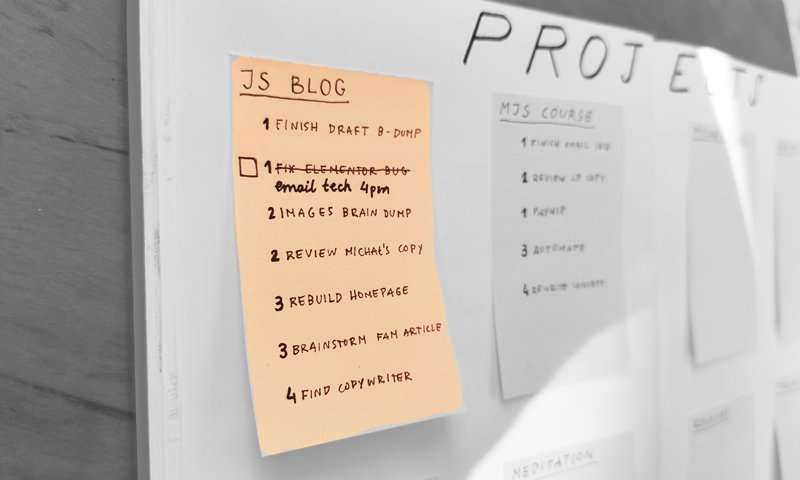
Different items might need different specifications. For example, if your Next Action is an idea that you want to bring to life, you might want to define it as “write down [idea] in my ideas spread”, “use [idea] when writing my new article”, or “brainstorm [idea] with Mary at our work meeting tomorrow”.
Whatever it is, make sure you make it clear and tangible so you know exactly what to do next. This is the best antidote against procrastination!
Note: As you dive deeper, some Next Actions will turn out to be bigger and more complex than they seemed at first. In those cases, you can turn them into projects and write down all the relevant items under them.
Step 6: Take Action!
This one is quite straightforward: just do your Next Action in each project!
Sometimes, this will mean going out and doing it; other times, it might simply mean allocating a slot in your calendar for it.
Once this is done, you can tick the box next to it.
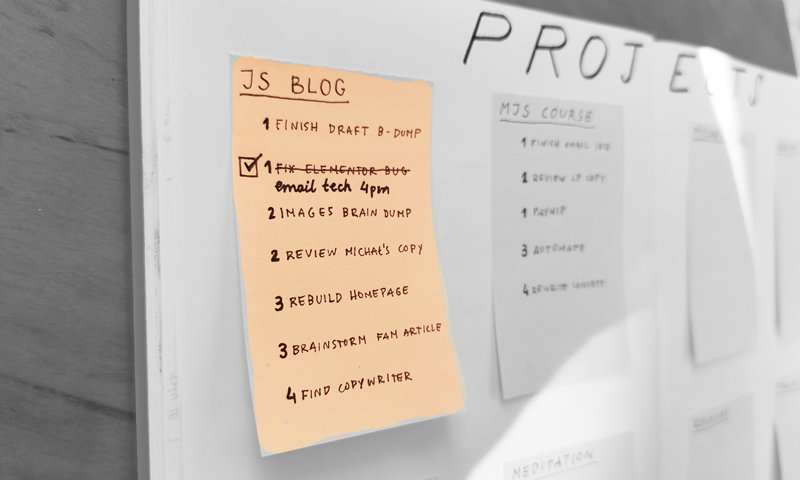
Two-minute rule: if it takes less than two minutes, do it right now.
Step 7: Define a New Next Action
Once you’ve completed your first Next Action in a project, it’s time to define a new one!
As you progress, you will eventually move on to priorities 2, 3, and 4.
This is another great opportunity to use your bullet journal to your advantage!
Depending on the priority of each item, you can write down your next action on:
- Your daily spread
- Your weekly spread
- Your monthly spread
- Your future log
- Your goals page
In some cases, you might even want to create a new spread (for example, a fitness tracker, or a meal plan page).
Once you reach your 4th Priority (Let Go!), you can simply take a moment with each item to acknowledge that you are letting it go. Some things only need to be brought to awareness so they can be released. You might also want to delegate some of them to other people—in that case, adjust your Next Action accordingly.
Step 8: Repeat the Brain Dump
When and how often should you do a brain dump?
The quick answer is: as often as you need it.
Some people like to do it every week; I personally like to use it as a special weapon for those times when I feel especially overwhelmed, stressed, or completely lost and swamped in projects and deadlines.
Here are a few occasions when it might be helpful to do a brain dump:
- When you feel inspired and need to organize all the new ideas in your head;
- When you feel frustrated, unbalanced, or confused;
- When you have lots of clients or projects going on;
- When you’re planning out the next month, semester, year, etc.;
- After learning something new – brain dumps are great to consolidate knowledge, and students and teachers love this tool!
Achieving an Empty, Creative Mind Is Easier Than It Seems…
All you need to do is take some time to declutter your thoughts.
It’s just like cleaning your house. Sometimes, a general sweep is enough—in those cases, Step 1 might be all you need.
However, if you want to go deeper and do some serious spring cleaning, follow all the eight steps—this will help you get your life organized, eliminate overwhelm, and completely refresh your state of mind.
Note: If this is useful, you can help JournalSmarter to exist and buy a pdf version of this article. No pressure, though. We love you anyway!